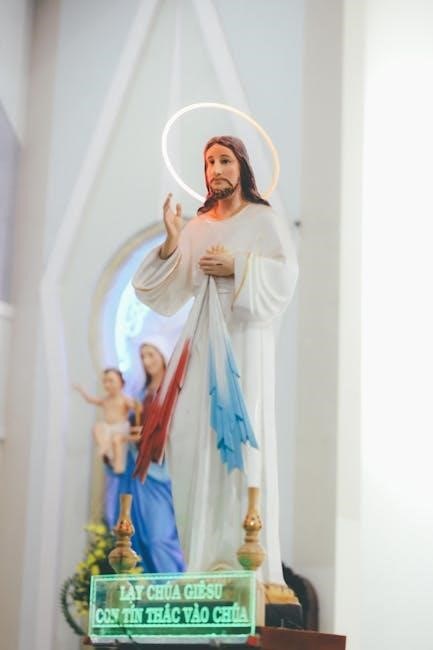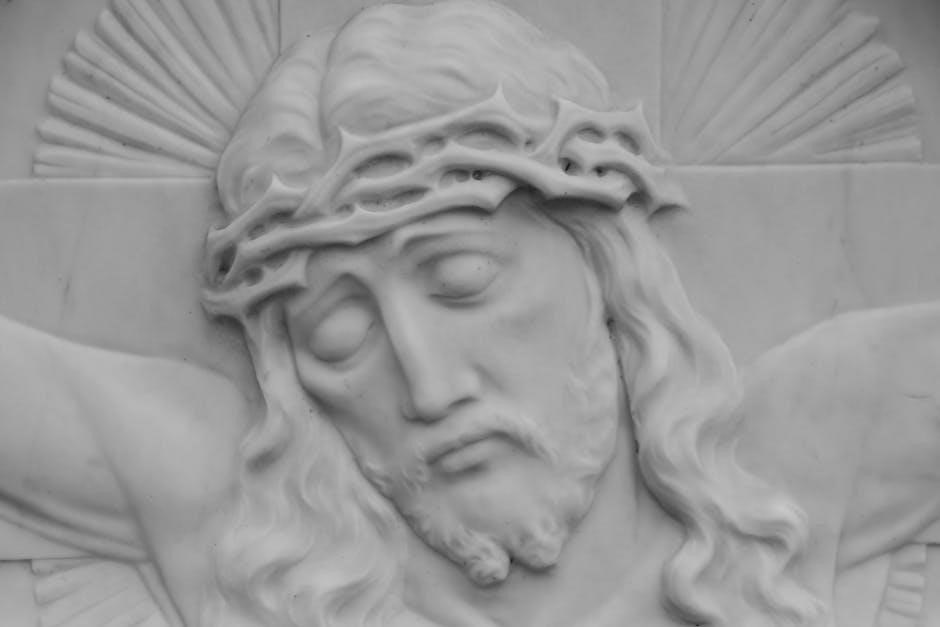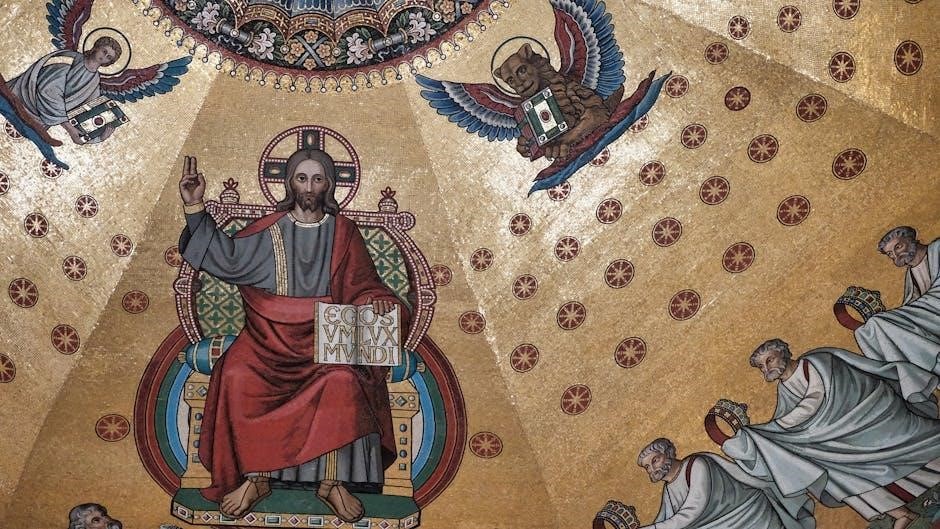Handel’s Messiah PDF is a digital version of the iconic Baroque oratorio, composed in 1741. This sacred masterpiece, based on biblical texts, remains a cornerstone of classical music, offering convenience for modern study and performance.
Overview of Handel’s Messiah
Handel’s Messiah is a monumental sacred oratorio composed in 1741, comprising three parts that narrate the prophecy, life, and resurrection of Jesus Christ. Its libretto, crafted by Charles Jennens, draws from the King James Bible, creating a profound religious narrative. The work is renowned for its majestic choruses, such as the iconic “Hallelujah Chorus,” and its intricate orchestration. Originally performed at Easter, it has since become a beloved Christmas tradition worldwide. The oratorio’s enduring appeal lies in its emotional depth and universal themes of hope and redemption. Its structure, divided into 53 movements, showcases Handel’s masterful blending of solo vocals, chorus, and orchestra, cementing its status as a cornerstone of classical music.
Importance of the Messiah PDF Version
The Messiah PDF version offers unparalleled accessibility to Handel’s timeless oratorio, allowing scholars, performers, and enthusiasts to engage with the score digitally. This format preserves the original composition’s integrity while enabling easy sharing and study. For musicians, the PDF provides a convenient resource for practice and performance, ensuring accuracy and consistency. It also serves as a valuable educational tool, offering insights into Baroque-era composition techniques and historical performance practices. The PDF’s availability has democratized access to this masterpiece, fostering global appreciation and ensuring its continued relevance in contemporary musical culture. Its digital form bridges the past and present, making Handel’s genius accessible to future generations.

Historical Background of Handel’s Messiah
Composed in 1741, Handel’s Messiah is a Baroque-era oratorio originally performed at Easter but later became a beloved Christmas tradition, showcasing its enduring cultural significance.
The Premiere and Initial Reception
Handel’s Messiah premiered on April 13, 1742, in Dublin, Ireland, at the New Music Hall in Fishamble Street. The performance was a charity event, raising funds for local hospitals and debtors’ prisons. The audience, numbering around 700, responded enthusiastically, with accounts describing the crowd’s emotional reaction to the “Hallelujah Chorus.” Despite its success in Dublin, the Messiah faced challenges in London due to its religious themes and unconventional format for an oratorio. Initially, some critics found it too sacred for public performance, but it gradually gained acceptance. Over time, the Messiah became a cornerstone of Western classical music, with its premiere marking the beginning of its enduring legacy as a cultural and spiritual masterpiece.
Charles Jennens and His Role as Librettist
Charles Jennens, an English aristocrat and scholar, played a pivotal role in the creation of Handel’s Messiah by compiling the libretto. Jennens carefully selected and arranged texts from the King James Bible, focusing on themes of redemption, prophecy, and divine glory. His structured approach divided the oratorio into three parts, reflecting the life of Christ, His death and resurrection, and the spread of Christianity. Jennens’ collaboration with Handel was crucial, as he ensured the text aligned with Handel’s compositional style. Despite their artistic differences, Jennens’ libretto provided the spiritual and narrative foundation for the Messiah, making it a timeless masterpiece. His work remains a testament to the fusion of theology and music in the Baroque era.
Original Purpose and Performance Context
Handel’s Messiah was originally composed for a charitable concert series in Dublin, aimed at raising funds for local hospitals and debtors’ prisons. The first performance on April 13, 1742, featured a modest orchestra of about 40 musicians and a choir of 100 singers. Although commonly associated with Easter, the Messiah was not initially tied to a specific religious holiday. Instead, it was part of a broader effort to bring orchestral music to the public, blending sacred themes with grand musical expression. This context emphasized accessibility and community engagement, setting the stage for its enduring popularity and universal appeal.

Composition and Structure of the Messiah
Handel’s Messiah is structured as an oratorio in three parts, comprising 53 movements, including arias, choruses, and recitatives. It blends biblical texts with grand musical expression, showcasing Handel’s mastery of choral and orchestral composition.
Three Parts of the Oratorio
Handel’s Messiah is divided into three distinct parts, each reflecting a different narrative and theological theme. The first part focuses on the prophecy and birth of Jesus, drawing from Old Testament texts. The second part depicts Christ’s passion, resurrection, and the spread of Christianity, emphasizing redemption. The third part explores the resurrection’s triumph and the final judgment, culminating in a glorious hymn of praise. This tripartite structure creates a dramatic arc, guiding listeners through sacred history. Each part is rich with arias, choruses, and recitatives, showcasing Handel’s masterful integration of text and music to convey profound spiritual messages. This design ensures a cohesive and impactful storytelling experience.

Famous Choruses and Their Significance
Handel’s Messiah is renowned for its iconic choruses, which have become cornerstone pieces in classical music. The “Hallelujah Chorus” is the most celebrated, often performed with audiences standing in reverence. Its triumphant melody and harmonious layers embody the joy of Christ’s resurrection. Another notable chorus, “For unto Us a Child is Born,” showcases Handel’s skill in crafting uplifting, celebratory music. These choruses are not only musically sublime but also deeply theological, reflecting themes of redemption and divine glory. They connect listeners to the spiritual narrative, making the Messiah a timeless work of art and devotion.
The Role of the Libretto in the Composition
The libretto of Handel’s Messiah, crafted by Charles Jennens, plays a pivotal role in shaping the oratorio’s narrative and emotional depth. Drawn from biblical texts, primarily the Old and New Testaments, the libretto weaves a spiritual journey from prophecy to redemption. Its structure, divided into three parts, provides a clear framework for Handel’s music, allowing him to evoke powerful emotions through composition. The libretto’s thematic coherence and theological richness inspired Handel to create some of his most iconic movements. Jennens’ careful selection of texts ensured the oratorio’s universality, making it a timeless masterpiece. The collaboration between Jennens’ libretto and Handel’s music remains central to the work’s enduring appeal and spiritual resonance.

Musical Elements of the Messiah
Handel’s Messiah masterfully blends grandeur and emotion through orchestration, choral pieces, and solo vocals, creating a harmonic balance that elevates the spiritual narrative to timeless heights.
Orchestration and Vocal Arrangements
Handel’s Messiah showcases exceptional orchestration, blending strings, woodwinds, brass, and timpani to create a dynamic and expressive soundscape. The orchestral arrangements are meticulously crafted to complement the vocal elements, achieving a perfect balance between grandeur and intimacy. Vocal arrangements feature both soloists and chorus, with intricate harmonies that highlight the emotional depth of the libretto. Soloists often perform virtuosic arias, while the chorus delivers powerful, unified expressions of joy, sorrow, and triumph. The interplay between orchestral and vocal forces underscores the dramatic narrative, making the Messiah a landmark of Baroque music. Handel’s mastery of texture and timbre ensures that each section, whether orchestral or choral, contributes to the work’s enduring appeal and spiritual resonance.
Key Movements and Their Emotional Impact

Handel’s Messiah is renowned for its emotionally profound movements, each crafted to evoke specific feelings and spiritual reflections. The iconic “Hallelujah Chorus” stands out as a triumphant celebration of divine sovereignty, while “He Was Despised” conveys deep sorrow and compassion. “The Trumpet Shall Sound” offers hope and resurrection, its fanfare symbolizing victory over death. These movements, along with others like “For Unto Us a Child Is Born” and “Rejoice Greatly,” create a narrative arc from prophecy to redemption. Their emotional depth resonates universally, connecting audiences to the spiritual essence of the oratorio. The interplay of joy, lament, and triumph ensures that Messiah remains a timeless masterpiece of emotional and spiritual expression.
Handel’s Unique Compositional Techniques
Handel’s Messiah showcases his mastery of counterpoint and choral writing, blending operatic grandeur with sacred text. His innovative use of repetition and thematic development ties the work together, creating a cohesive narrative. The oratorio’s structure, divided into three parts, reflects Handel’s operatic experience, with dramatic contrasts between solos, chorus, and instrumental interludes. His ability to balance grandeur and intimacy, such as in the shift from the triumphant “Hallelujah Chorus” to the reflective “He Was Despised,” demonstrates his compositional genius. Handel’s use of motifs, like the descending scale in “For Unto Us a Child Is Born,” adds depth and unity. His approach to text setting prioritizes emotional expression, ensuring the music enhances the libretto’s spiritual message.

Performances and Interpretations
Handel’s Messiah has been performed in traditional and modern interpretations, featuring varied orchestration and vocal styles, each highlighting its enduring cultural and musical significance.
Traditional vs. Modern Interpretations
Handel’s Messiah is performed in both traditional and modern styles, reflecting evolving musical tastes. Traditional interpretations often adhere to period-authentic practices, using smaller ensembles, harpsichord continuo, and historically informed vocal techniques. These performances aim to recreate the sound and spirit of the 18th century, emphasizing clarity and precision. In contrast, modern interpretations may incorporate larger orchestras, diverse vocal arrangements, and innovative instrumental accompaniments, offering fresh perspectives on the classic work. These adaptations often blend traditional elements with contemporary influences, such as world music or electronic elements, to appeal to a broader audience. Both approaches highlight the timeless appeal of the Messiah, allowing it to resonate with listeners across generations and cultural contexts.
Despite these differences, both traditional and modern interpretations maintain the emotional and spiritual core of the Messiah, ensuring its continued relevance and universal appeal.
Famous Performances and Their Cultural Impact
Handel’s Messiah has been performed countless times since its premiere, with certain renditions leaving an indelible mark on cultural history. The 1750 performance in London, benefiting the Foundling Hospital, solidified its charitable legacy and public appeal. In 1789, a grand commemoration concert for Handel in Westminster Abbey showcased the Messiah to a massive audience, cementing its status as a national treasure. Modern performances, such as the 1980s recordings by Sir Georg Solti and the Chicago Symphony Orchestra, introduced the Messiah to global audiences through mass distribution. These iconic performances have not only preserved the Messiah’s artistic integrity but also expanded its reach, making it a cornerstone of classical music and a symbol of cultural and spiritual enrichment worldwide. Each rendition continues to inspire new generations, ensuring its enduring legacy.
These performances highlight the Messiah’s ability to transcend time and connect with diverse audiences, fostering a shared cultural experience.
Evolution of Performance Practices
Performance practices of Handel’s Messiah have evolved significantly since its premiere, reflecting changing musical tastes and historical contexts. Initially performed with a small Baroque orchestra and choir, modern productions often feature larger ensembles, including symphony orchestras and extensive choruses. The 19th century saw Romantic-era interpretations, with expanded instrumentation and dramatic dynamics, while the 20th century witnessed a return to period-specific instruments and historically informed performances. Conductors have also experimented with tempos and articulations, balancing tradition with innovation. These shifts demonstrate the Messiah’s adaptability, ensuring its relevance across generations while maintaining its core emotional and spiritual impact.
Such evolutionary changes highlight the Messiah’s enduring appeal and its ability to resonate with diverse musical aesthetics and cultural values.

Cultural and Religious Significance
Handel’s Messiah is a cultural and religious pillar, reflecting spiritual themes and redemption through music. It’s a Christmas tradition, evoking global spiritual connection, bridging cultural and devotional elements.
Messiah as a Christmas Tradition
Handel’s Messiah has become a beloved Christmas tradition worldwide, despite its original association with Lent. Its majestic choruses, particularly the “Hallelujah Chorus,” evoke the celebratory spirit of Christmas. Many communities and choirs perform the oratorio during the holiday season, fostering a sense of unity and shared cultural heritage. The work’s themes of redemption and divine glory resonate deeply during Christmas, aligning with the narrative of Christ’s birth. This tradition, though not Handel’s intent, underscores the Messiah’s timeless appeal and its ability to transcend its original context, making it a cornerstone of holiday celebrations globally.
Religious Themes and Their Representation

Handel’s Messiah is deeply rooted in religious themes, drawing its libretto from biblical texts. The oratorio explores the life, death, and resurrection of Jesus Christ, emphasizing divine redemption and salvation. Its structure is divided into three parts: the prophecy of Christ, His Passion and crucifixion, and the triumph of His resurrection. The music and text work together to convey profound theological messages, such as hope, forgiveness, and eternal life. Choruses like “Hallelujah” and “For unto Us a Child Is Born” reflect the joy and reverence associated with these themes. The Messiah’s religious core resonates universally, making it a powerful expression of faith and spirituality, accessible to both believers and non-believers alike.
Global Popularity and Cultural Adaptations
Handel’s Messiah has achieved unparalleled global popularity, transcending cultural and geographical boundaries. Its universal appeal lies in its ability to evoke emotions and inspire diverse audiences. The oratorio is performed worldwide, with countless adaptations, from traditional orchestral arrangements to modern interpretations in gospel, rock, and even electronic music. Its iconic “Hallelujah Chorus” has become a cultural phenomenon, featured in films, commercials, and sports events. The Messiah has also been translated into multiple languages, further broadening its reach. This adaptability ensures its relevance in contemporary culture, making it a timeless masterpiece that continues to resonate with people of all backgrounds. Its enduring popularity underscores its significance as a global cultural treasure.
Handel’s Messiah remains a timeless masterpiece, captivating audiences with its enduring influence and global popularity, solidifying its place as a cornerstone of classical music heritage.
Legacy of Handel’s Messiah
Handel’s Messiah stands as a cornerstone of classical music, leaving an indelible mark on choral and orchestral traditions. Its timeless themes and soaring melodies have inspired countless composers and performers, shaping the evolution of sacred music. The oratorio’s global popularity endures, with its iconic choruses like “Hallelujah” becoming cultural touchstones. Beyond its religious significance, Messiah has transcended boundaries, adapting to diverse interpretations while retaining its emotional and spiritual resonance. Its influence extends to modern adaptations, from orchestral rearrangements to contemporary performances, ensuring its relevance across generations. As a testament to Handel’s genius, Messiah continues to unite audiences worldwide, solidifying its legacy as a masterpiece of enduring artistry and universal appeal.

Continued Relevance in Modern Times
Handel’s Messiah remains a vital work in modern musical and cultural landscapes, resonating with audiences across generations. Its universal themes of hope, redemption, and divine inspiration continue to captivate listeners, transcending time and cultural boundaries. Modern performances often blend traditional and contemporary interpretations, introducing the masterpiece to new audiences. The availability of the Messiah PDF has further enhanced its accessibility, enabling musicians, scholars, and enthusiasts to study and perform the work worldwide. Its adaptability to diverse settings, from grand orchestral renditions to intimate chamber arrangements, ensures its enduring appeal. As a cultural and spiritual touchstone, Messiah continues to inspire creativity and reflection, solidifying its place in the modern musical canon.
Final Thoughts on the Messiah PDF
The Messiah PDF serves as a timeless resource, preserving Handel’s masterpiece for future generations. Its digital format ensures accessibility, allowing scholars, musicians, and enthusiasts to explore the work in depth. The PDF captures the essence of Handel’s composition, offering a comprehensive view of the score and libretto. It also facilitates study and performance, making it an invaluable tool for both professionals and amateurs. As a historical document, it bridges the past and present, enabling contemporary interpretations while honoring the original intent. The Messiah PDF underscores the enduring legacy of Handel’s work, ensuring its continued relevance and inspiration in the digital age.
